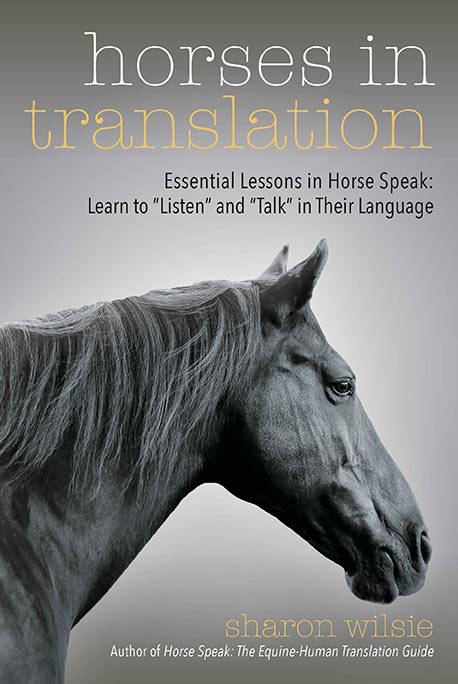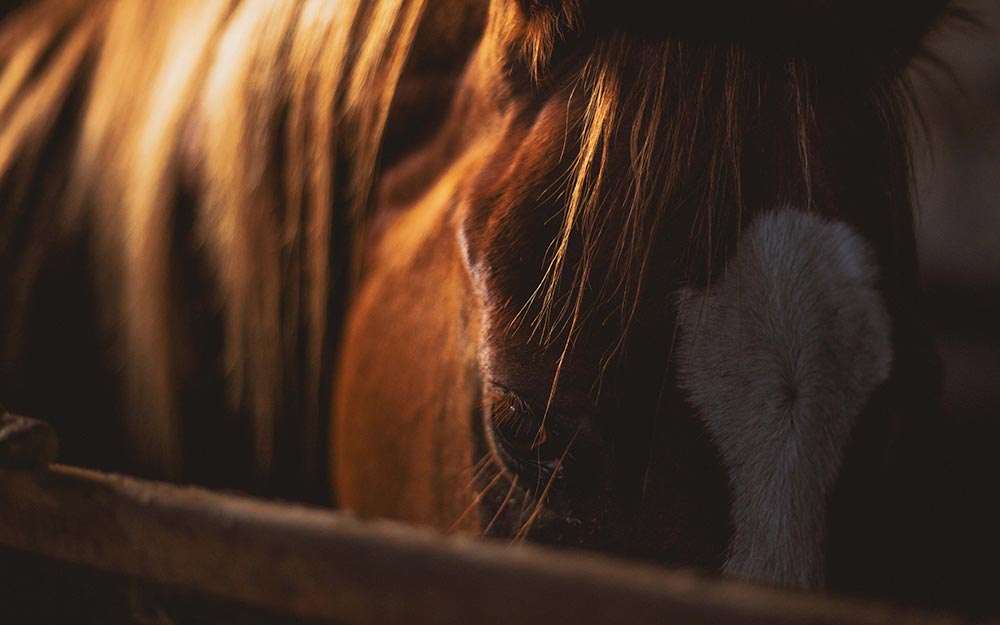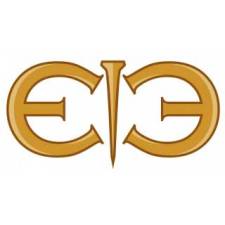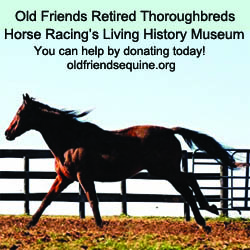
In the fall of 2017, horse trainer and rehabilitation specialist Sharon Wilsie took the international horse world by storm with her system of “Horse Speak” and the bestselling book by the same name. It offered a practical approach to “listening” and “talking” to horses in their language instead of expecting them to comprehend ours. In her new book Horses in Translation, Wilsie tells true stories of how serious “problems” can be solved using Horse Speak, like this one, about an OTTB and the woman who desperately wanted to connect with him.
Only a few weeks after buying an off-the-track Thoroughbred named Journey, Ann started to have her suspicions as to why the horse had been so reasonably priced. As Journey settled into his new home, a “mean side” started to show up. For reasons Ann could not fathom, he would suddenly glaze over, and rear, kick, or bite.
At first Ann applied herself to trying to figure out what the triggers were, but as time went on, she came to realize that she simply could not figure out her horse, no matter how hard she tried. Things degenerated to the point where she could not even go near him without a whip in her hand for self-defense. Finally, even that failed: One day Journey grabbed her by the upper arm, nearly breaking it as he tossed her like a rag doll several feet away.
Ann reached out to me in a state of desperation. I was traveling to her area for a clinic and said I would carve out some time to meet with her and see what could be done. Ann had done some homework and tracked down what she could of Journey’s history. He had raced until he was four, and then, considered washed up, he’d been gelded and sold off at auction. Since then, he had been through several homes, and each time trainers had been called in to try and help solve his issues. Through it all he only seemed to get worse. Now that he was 11, Ann felt for certain that she was Journey’s last hope. And if she could not help him, she would not sell him either, because she felt he was a danger to others. She had decided he could live out his days on the farm, and no one would touch him.
Journey lived in a one-acre paddock attached to a stall, which he could go in and out of at will. There was an ancient Mustang with him, and they seemed joined at the hip. I blew a soft greeting at the Mustang first, nodding my head and walking up and down the fence line in three changes of direction to show my interest in talking. The Mustang stared for a moment, then did an “Aw-Shucks” and breathed back at me. He took a step forward, but Journey pinned his ears and blocked his movement. The Mustang breathed toward me, then turned and walked away.
I wanted to talk to the elder horse first, thinking that this would help me introduce myself to Journey. The fact that the conversation was so rudely blocked was not a great sign…but it did give me a lot to think about. Information gathering is as important as anything else.
I changed my tactics and kicked the fence posts a little, then checked the water tub in the corner and tossed some hay into the hay bucket. I wanted to show Journey that I was a person who meant business. If I lingered on just trying to make contact with him, he would not be interested. By blocking the Mustang, he had already told me he didn’t like people.
I turned my back to the horses and began talking to Ann. As we talked, I moved her to the left a step, then reached out and moved her back to the right. Whether Journey “liked” her or not, he perceived Ann as “his,” and by moving her around a little bit, I was claiming her as “mine” in that moment—very similarly to how he had claimed the Mustang a few minutes before. That got his interest. Just because he was sometimes mean to her didn’t mean he didn’t think she was his.
The Thoroughbred blew out his nose loudly and nodded his head deliberately.
I perceived this as rather like a stallion challenging another stallion. It was possible that the later-in-life gelding had left him a bit more “studdy” than we would have liked. Healthy stallion leadership in a balanced herd is often very tender and soft toward herd mares and foals. Stallions can and do use force to protect their herd and sometimes can be more forceful toward members of their band if they are stressed or trying to drive everyone forward in times of danger. In domestic situations, however, stallions rarely have healthy relationships with their family groups and are kept isolated instead. In many cases, the humans who own stallions want to channel all that power into a performance, but without a healthy family group to experience life with, stallions can often get out of control.
I observed Journey’s overreactions to everything. I had no proof yet that this was the case with him, but the more I watched him, the more he reminded me of the troubled stallions I had worked with over the years. I decided to proceed with an awareness that he might be poorly socialized to begin with and possibly very unclear about healthy boundaries, even with other horses.
Journey marched over to the fence. Ann was glad to see him come toward us because, she said, he could often be very reclusive. I, too, was glad to see him come over, but I also took note of the fact that he approached very high-headed, with his poll arched—more dominant communication.
I offered my knuckles to him but remained slightly out of reach. He would have to stretch his neck all the way out to say hello. As he did, he pinned his ears and rolled his eyes, acting like he would bite. I knew I was just slightly out of reach, so I did not flinch, but remained still, breathing deeply. He pulled his head away and regrouped. I turned to the side and “scanned the horizon” (looking far and wide for any threats or danger) for a half-second, then firmly stuck my fist toward him again. This time, Journey paused for a moment and actually seemed to look at me, instead of just reacting to my presence. He reached toward my knuckle again and this time sniffed it from an inch away. As he retracted his head, I turned to the side again, and scuffed the ground in an “Aw-Shucks.”

My goal was to model a formal Greeting, and to communicate I wanted him to “turn the volume down.” I had told him I was aware of the environment and that I had a certain relationship with his human. I did not want to diminish him in any way, but I did aim to offer a calm leadership—the way an older mare would. I have been lucky enough to watch older mares teach overzealous geldings or young studs about manners. They are very serious about making the boys follow the rules of engagement, and although they can and will use their powerful hindquarters to make a statement if they have to, these mares usually simply repeat the essay on manners over and over again, drilling the adolescent behavior right out of the offenders. The “boys” are not allowed to remain close to a mare unless they are calm.
I would have to take on the manners of a mature mare to change the Thoroughbred’s attitude I guessed that many previous trainers had probably taken the stance of trying to get Journey to cower in submission. That would be like a stallion taking on a stallion; I had no interest in that sort of activity or relationship.
I was going to adopt the curt, punctual dialogue of a no-nonsense teacher who has taught school for a million years and expected to get through the lesson no matter what “Little Timmy” was doing. I would not be dragged into drama by this horse. Instead I would model the code of behavior I expected him to follow. I set myself up mentally to sit right in the center of his hurricane and not budge. In a situation like Journey’s, where the horse did not have good social skills, I was going to have to fill in where his mother left off.
This excerpt from Horses in Translation by Sharon Wilsie is reprinted with permission from Trafalgar Square Books (www.horseandriderbooks.com).
We have many Thoroughbred rehoming organizations on EIE! Find your next equine companion on our Rehoming page!













